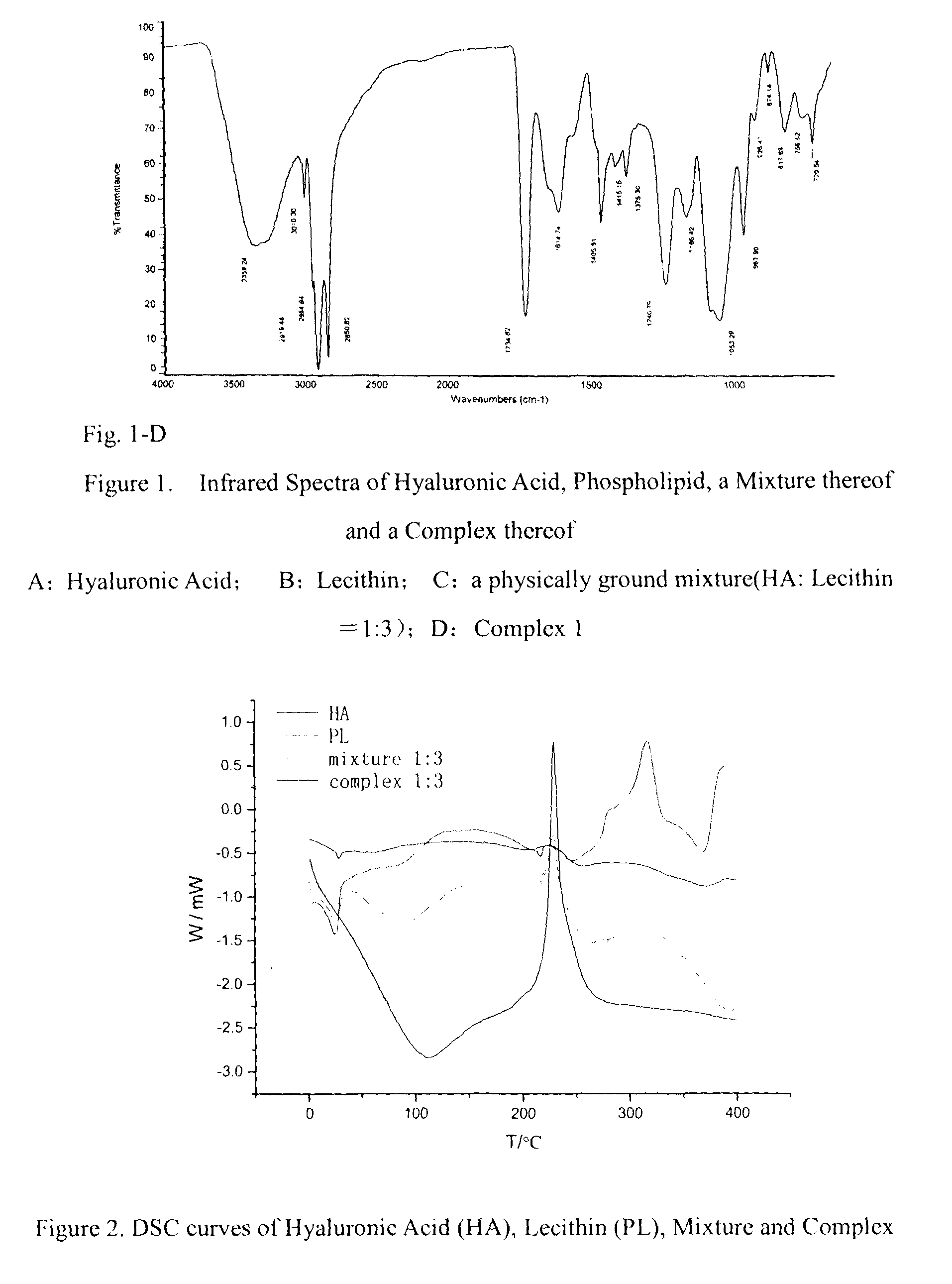Oral agent for improving and protecting the function of joint comprising hyaluronic acid-phospholipid complexes
a technology of hyaluronic acid and phospholipid complex, which is applied in the direction of biocide, sugar derivates, drug compositions, etc., can solve the problems of poor compliance, less effective in serious and advanced oa, and serious impairing working ability
- Summary
- Abstract
- Description
- Claims
- Application Information
AI Technical Summary
Benefits of technology
Problems solved by technology
Method used
Image
Examples
preparation example 1
Preparation and Identification of Hyaluronic Acid-Phospholipid Complex 1
[0030]1.2 g sodium hyaluronate was accurately weighed and added slowly to 100 ml phosphate buffer with stirring until complete dissolution. 3.6 g lecithin (Lipoid E 80 from Lipoid Co., Germany, which contains about 80% phosphatidylchloline, about 8% phosphatidylethanolamine, and small amounts of sphingomyelin, lysophospholipid and the like) was accurately weighed and dissolved in anhydrous ethanol. The ethanol was then removed by rotary evaporation, leaving a film of phospholipid on the flask wall, followed by vacuum drying to completely remove ethanol. The resulting phospholipids film was hydrated by addition of 100 ml phosphate buffer with mechanical stirring, and was ultrasonicated for 10 min to obtain a homogenous dispersion, before adding to the previously prepared hyaluronic acid solution. 6 hrs of mechanical stirring at a constant temperature of 37° C. yielded the hyaluronic acid-phospholipid Complex 1. I...
preparation example 2
Preparation and Identification of Hyaluronic Acid-Phospholipid Complex 2
[0041]The procedures for preparing Complex 2 were the same as those for preparing Complex 1, except that 1.2 g sodium hyaluronate and 0.24 g phospholipid used in Example 1 respectively were accurately weighed. In this example, the mass ratio of the starting hyaluronic acid to phospholipid is 1:0.2. The complexation state of phospholipid and hyaluronic acid in Complex 2 was determined as described for Complex 1, and the result showed that the mass ratio of phospholipid to hyaluronic acid being complexed was 0.1886. Complex 2 was identified by the same methods as those used for Complex 1, and the results showed that its IR absorption profile and change in thermochemical properties were substantially the same as Complex 1.
preparation example 3
Preparation and Identification of Hyaluronic Acid-Phospholipid Complex 3
[0042]The procedures for preparing Complex 3 were the same as those for preparing Complex 1, except that 1.2 g sodium hyaluronate and 10.8 g phospholipid used in Example 1 respectively were accurately weighed. In this example, the mass ratio of the starting hyaluronic acid to phospholipid is 1:9. The complexation state of phospholipid and hyaluronic acid in Complex 3 was determined as described for Complex 1, and the result showed that the mass ratio of phospholipid to hyaluronic acid being complexed was 0.4805. Complex 3 was identified by the same methods as those used for Complex 1, and the results showed that its IR absorption profile and change in thermochemical properties were also substantially the same as Complex 1.
PUM
| Property | Measurement | Unit |
|---|---|---|
| Mass | aaaaa | aaaaa |
| Mass | aaaaa | aaaaa |
| Volume | aaaaa | aaaaa |
Abstract
Description
Claims
Application Information
 Login to View More
Login to View More - R&D
- Intellectual Property
- Life Sciences
- Materials
- Tech Scout
- Unparalleled Data Quality
- Higher Quality Content
- 60% Fewer Hallucinations
Browse by: Latest US Patents, China's latest patents, Technical Efficacy Thesaurus, Application Domain, Technology Topic, Popular Technical Reports.
© 2025 PatSnap. All rights reserved.Legal|Privacy policy|Modern Slavery Act Transparency Statement|Sitemap|About US| Contact US: help@patsnap.com


